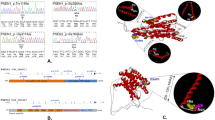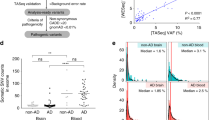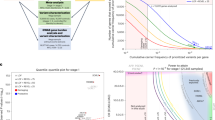Abstract
We hypothesized that de novo variants (DNV) might participate in the genetic determinism of sporadic early-onset Alzheimer disease (EOAD, onset before 65 years). We investigated 14 sporadic EOAD trios first by array-comparative genomic hybridization. Two patients carried a de novo copy number variation (CNV). We then performed whole-exome sequencing in the 12 remaining trios and identified 12 non-synonymous DNVs in six patients. The two de novo CNVs (an amyloid precursor protein (APP) duplication and a BACE2 intronic deletion) and 3/12 non-synonymous DNVs (in PSEN1, VPS35 and MARK4) targeted genes from a biological network centered on the Amyloid beta (Aβ) peptide. We showed that this a priori-defined genetic network was significantly enriched in amino acid-altering DNV, compared with the rest of the exome. The causality of the APP de novo duplication (which is the first reported one) was obvious. In addition, we provided evidence of the functional impact of the following three non-synonymous DNVs targeting this network: the novel PSEN1 variant resulted in exon 9 skipping in patient’s RNA, leading to a pathogenic missense at exons 8–10 junction; the VPS35 missense variant led to partial loss of retromer function, which may impact neuronal APP trafficking and Aβ secretion; and the MARK4 multiple nucleotide variant resulted into increased Tau phosphorylation, which may trigger enhanced Aβ-induced toxicity. Despite the difficulty to recruit Alzheimer disease (AD) trios owing to age structures of the pedigrees and the genetic heterogeneity of the disease, this strategy allowed us to highlight the role of de novo pathogenic events, the putative involvement of new genes in AD genetics and the key role of Aβ network alteration in AD.
This is a preview of subscription content, access via your institution
Access options
Subscribe to this journal
Receive 12 print issues and online access
$259.00 per year
only $21.58 per issue
Buy this article
- Purchase on Springer Link
- Instant access to full article PDF
Prices may be subject to local taxes which are calculated during checkout




Similar content being viewed by others
References
Lambert JC, Ibrahim-Verbaas CA, Harold D, Naj AC, Sims R, Bellenguez C et al. Meta-analysis of 74,046 individuals identifies 11 new susceptibility loci for Alzheimer's disease. Nat Genet 2013; 45: 1452–1458.
Jonsson T, Stefansson H, Steinberg S, Jonsdottir I, Jonsson PV, Snaedal J et al. Variant of TREM2 associated with the risk of Alzheimer's disease. N Engl J Med 2013; 368: 107–116.
Cruchaga C, Karch CM, Jin SC, Benitez BA, Cai Y, Guerreiro R et al. Rare coding variants in the phospholipase D3 gene confer risk for Alzheimer's disease. Nature 2014; 505: 550–554.
Gratten J, Visscher PM, Mowry BJ, Wray NR . Interpreting the role of de novo protein-coding mutations in neuropsychiatric disease. Nat Genet 2013; 45: 234–238.
Veltman JA, Brunner HG . De novo mutations in human genetic disease. Nat Rev Genet 2012; 13: 565–575.
McKhann GM, Knopman DS, Chertkow H, Hyman BT, Jack CR Jr., Kawas CH et al. The diagnosis of dementia due to Alzheimer's disease: recommendations from the National Institute on Aging-Alzheimer's Association workgroups on diagnostic guidelines for Alzheimer's disease. Alzheimers Dement 2011; 7: 263–269.
Perreau VM, Orchard S, Adlard PA, Bellingham SA, Cappai R, Ciccotosto GD et al. A domain level interaction network of amyloid precursor protein and Abeta of Alzheimer's disease. Proteomics 2010; 10: 2377–95.
Gokool S, Tattersall D, Seaman MN . EHD1 interacts with retromer to stabilize SNX1 tubules and facilitate endosome-to-Golgi retrieval. Traffic 2007; 8: 1873–1886.
Helfer E, Harbour ME, Henriot V, Lakisic G, Sousa-Blin C, Volceanov L et al. Endosomal recruitment of the WASH complex: active sequences and mutations impairing interaction with the retromer. Biol Cell 2013; 105: 191–207.
Breusegem SY, Seaman MN . Image-based and biochemical assays to investigate endosomal protein sorting. Methods Enzymol 2014; 534: 155–178.
Harbour ME, Breusegem SY, Antrobus R, Freeman C, Reid E, Seaman MN . The cargo-selective retromer complex is a recruiting hub for protein complexes that regulate endosomal tubule dynamics. J Cell Sci 2010; 123: 3703–3717.
Seaman MN, Harbour ME, Tattersall D, Read E, Bright N . Membrane recruitment of the cargo-selective retromer subcomplex is catalysed by the small GTPase Rab7 and inhibited by the Rab-GAP TBC1D5. J Cell Sci 2009; 122: 2371–2382.
Nesic D, Miller MC, Quinkert ZT, Stein M, Chait BT, Stebbins CE . Helicobacter pylori CagA inhibits PAR1-MARK family kinases by mimicking host substrates. Nat Struc Mol Biol 2010; 17: 130–132.
Halgren TA, Murphy RB, Friesner RA, Beard HS, Frye LL, Pollard WT et al. Glide: a new approach for rapid, accurate docking and scoring. 2. Enrichment factors in database screening. J Med Chem 2004; 47: 1750–1759.
Lindorff-Larsen K, Piana S, Palmo K, Maragakis P, Klepeis JL, Dror RO et al. Improved side-chain torsion potentials for the Amber ff99SB protein force field. Proteins 2010; 78: 1950–1958.
Campbell CD, Eichler EE . Properties and rates of germline mutations in humans. Trends Genet 2013; 29: 575–584.
Hardy J, Selkoe DJ . The amyloid hypothesis of Alzheimer's disease: progress and problems on the road to therapeutics. Science 2002; 297: 353–356.
Pottier C, Wallon D, Lecrux AR, Maltete D, Bombois S, Jurici S et al. Amyloid-beta protein precursor gene expression in alzheimer's disease and other conditions. J Alzheimers Dis 2012; 28: 561–566.
Rovelet-Lecrux A, Hannequin D, Raux G, Le Meur N, Laquerriere A, Vital A et al. APP locus duplication causes autosomal dominant early-onset Alzheimer disease with cerebral amyloid angiopathy. Nature Genet 2006; 38: 24–26.
Sleegers K, Brouwers N, Gijselinck I, Theuns J, Goossens D, Wauters J et al. APP duplication is sufficient to cause early onset Alzheimer's dementia with cerebral amyloid angiopathy. Brain 2006; 129: 2977–2983.
Maunakea AK, Nagarajan RP, Bilenky M, Ballinger TJ, D'Souza C, Fouse SD et al. Conserved role of intragenic DNA methylation in regulating alternative promoters. Nature 2010; 466: 253–257.
Encode Project Consortium, Bernstein BE, Birney E, Dunham I, Green ED, Gunter C et al. An integrated encyclopedia of DNA elements in the human genome. Nature 2012; 489: 57–74.
Abdul-Hay SO, Sahara T, McBride M, Kang D, Leissring MA . Identification of BACE2 as an avid β-amyloid-degrading protease. Mol Neurodegener 2012; 7: 46.
Sun X, He G, Song W . BACE2 as a novel APP theta-secretase, is not responsible for the pathogenesis of Alzheimer's disease in Down syndrome. FASEB J 2006; 20: 1369–1376.
Perez-Tur J, Froelich S, Prihar G, Crook R, Baker M, Duff K et al. A mutation in Alzheimer's disease destroying a splice acceptor site in the presenilin-1 gene. Neuroreport 1995; 7: 297–301.
Steiner H, Romig H, Grim MG, Philipp U, Pesold B, Citron M et al. The biological and pathological function of the presenilin-1 Deltaexon 9 mutation is independent of its defect to undergo proteolytic processing. J Biol Chem 1999; 274: 7615–7618.
Rogaeva E, Meng Y, Lee JH, Gu Y, Kawarai T, Zou F et al. The neuronal sortilin-related receptor SORL1 is genetically associated with Alzheimer disease. Nat Genet 2007; 39: 168–177.
Pottier C, Hannequin D, Coutant S, Rovelet-Lecrux A, Wallon D, Rousseau S et al. High frequency of potentially pathogenic SORL1 mutations in autosomal dominant early-onset Alzheimer disease. Mol Psychiatry 2012; 17: 875–879.
Seaman MN, Gautreau A, Billadeau DD . Retromer-mediated endosomal protein sorting: all WASHed up!. Trends Cell Biol 2013; 23: 522–528.
McGough IJ, Steinberg F, Jia D, Barbuti PA, McMillan KJ, Heesom KJ et al. Retromer binding to FAM21 and the WASH complex Is perturbed by the Parkinson disease-linked VPS35(D620N) mutation. Curr Biol 2014; 24: 1670–1676.
Zavodszky E, Seaman MN, Moreau K, Jimenez-Sanchez M, Breusegem SY, Harbour ME et al. Mutation in VPS35 associated with Parkinson's disease impairs WASH complex association and inhibits autophagy. Nat Commun 2014; 5: 3828.
Small SA, Kent K, Pierce A, Leung C, Kang MS, Okada H et al. Model-guided microarray implicates the retromer complex in Alzheimer's disease. Ann Neurol 2005; 58: 909–919.
Muhammad A, Flores I, Zhang H, Yu R, Staniszewski A, Planel E et al. Retromer deficiency observed in Alzheimer's disease causes hippocampal dysfunction, neurodegeneration, and Abeta accumulation. Proc Natl Acad Sci USA 2008; 105: 7327–7332.
Sullivan CP, Jay AG, Stack EC, Pakaluk M, Wadlinger E, Fine RE et al. Retromer disruption promotes amyloidogenic APP processing. Neurobiol Dis 2011; 43: 338–345.
Wen L, Tang FL, Hong Y, Luo SW, Wang CL, He W et al. VPS35 haploinsufficiency increases Alzheimer's disease neuropathology. J Cell Biol 2011; 195: 765–779.
Bhalla A, Vetanovetz CP, Morel E, Chamoun Z, Di Paolo G, Small SA . The location and trafficking routes of the neuronal retromer and its role in amyloid precursor protein transport. Neurobiol Dis 2012; 47: 126–134.
Choy RW, Cheng Z, Schekman R . Amyloid precursor protein (APP) traffics from the cell surface via endosomes for amyloid beta (Abeta) production in the trans-Golgi network. Proc Natl Acad Sci USA 2012; 109: E2077–E2082.
Lane RF, Raines SM, Steele JW, Ehrlich ME, Lah JA, Small SA et al. Diabetes-associated SorCS1 regulates Alzheimer's amyloid-beta metabolism: evidence for involvement of SorL1 and the retromer complex. J Neurosci 2010; 30: 13110–13115.
Vieira SI, Rebelo S, Esselmann H, Wiltfang J, Lah J, Lane R et al. Retrieval of the Alzheimer's amyloid precursor protein from the endosome to the TGN is S655 phosphorylation state-dependent and retromer-mediated. Mol Neurodegener 2010; 5: 40.
Fjorback AW, Seaman M, Gustafsen C, Mehmedbasic A, Gokool S, Wu C et al. Retromer binds the FANSHY sorting motif in SorLA to regulate amyloid precursor protein sorting and processing. J Neurosci 2012; 32: 1467–1480.
Mecozzi VJ, Berman DE, Simoes S, Vetanovetz C, Awal MR, Patel VM et al. Pharmacological chaperones stabilize retromer to limit APP processing. Nat Chem Biol 2014; 10: 443–449.
Drewes G . MARKing tau for tangles and toxicity. Trends Biochem Sci 2004; 29: 548–555.
Gu GJ, Lund H, Wu D, Blokzijl A, Classon C, von Euler G et al. Role of individual MARK isoforms in phosphorylation of tau at Ser(2)(6)(2) in Alzheimer's disease. Neuromol Med 2013; 15: 458–469.
Yu W, Polepalli J, Wagh D, Rajadas J, Malenka R, Lu B . A critical role for the PAR-1/MARK-tau axis in mediating the toxic effects of Abeta on synapses and dendritic spines. Hum Mol Genet 2012; 21: 1384–1390.
Iijima K, Gatt A, Iijima-Ando K . Tau Ser262 phosphorylation is critical for Abeta42-induced tau toxicity in a transgenic Drosophila model of Alzheimer's disease. Hum Mol Genet 2010; 19: 2947–2957.
Nishimura I, Yang Y, Lu B . PAR-1 kinase plays an initiator role in a temporally ordered phosphorylation process that confers tau toxicity in Drosophila. Cell 2004; 116: 671–682.
Naz F, Anjum F, Islam A, Ahmad F, Hassan MI . Microtubule affinity-regulating kinase 4: structure, function, and regulation. Cell Biochem Biophys 2013; 67: 485–499.
Tanoue T, Adachi M, Moriguchi T, Nishida E . A conserved docking motif in MAP kinases common to substrates, activators and regulators. Nat Cell Biol 2000; 2: 110–116.
Iossifov I, O'Roak BJ, Sanders SJ, Ronemus M, Krumm N, Levy D et al. The contribution of de novo coding mutations to autism spectrum disorder. Nature 2014; 515: 216–221.
De Rubeis S, He X, Goldberg AP, Poultney CS, Samocha K, Cicek AE et al. Synaptic, transcriptional and chromatin genes disrupted in autism. Nature 2014; 515: 209–215.
Iossifov I, Ronemus M, Levy D, Wang Z, Hakker I, Rosenbaum J et al. De novo gene disruptions in children on the autistic spectrum. Neuron 2012; 74: 285–299.
Neale BM, Kou Y, Liu L, Ma'ayan A, Samocha KE, Sabo A et al. Patterns and rates of exonic de novo mutations in autism spectrum disorders. Nature 2012; 485: 242–245.
Dumanchin C, Brice A, Campion D, Hannequin D, Martin C, Moreau V et al. De novo presenilin 1 mutations are rare in clinically sporadic, early onset Alzheimer's disease cases. French Alzheimer's Disease Study Group. J Med Genet 1998; 35: 672–673.
Portet F, Dauvilliers Y, Campion D, Raux G, Hauw JJ, Lyon-Caen O et al. Very early onset AD with a de novo mutation in the presenilin 1 gene (Met 233 Leu). Neurology 2003; 61: 1136–1137.
Golan MP, Styczyńska M, Jóźwiak K, Walecki J, Maruszak A, Pniewski J et al. Early-onset Alzheimer's disease with a de novo mutation in the presenilin 1 gene. Exp Neurol 2007; 208: 264–268.
Vissers LE, de Ligt J, Gilissen C, Janssen I, Steehouwer M, de Vries P et al. A de novo paradigm for mental retardation. Nat Genet 2010; 42: 1109–1112.
Acknowledgements
Sponsored by CNR-MAJ and supported by grants from the Clinical Research Hospital Program from the French Ministry of Health (GMAJ, PHRC 2008/067). MNJS and SYB are funded through grants (G0701444 and MR/L007533/1) from the Medical Research Council awarded to MNJS. PJ is supported by grant BT/PR15118/BID/07/357/2011 from the Department of Biotechnology, Government of India. We thank the Integragen company for exome sequencing. We thank Pascal Chambon, Géraldine Joly, Soumeya Bekri and Stéphanie Torre for cultured fibroblasts, and Alessandro Beghini for the MARK4 plasmid. We thank Magalie Lecourtois and Emmanuelle Genin for helpful discussions and Tracey Avequin for editing the manuscript.
Author information
Authors and Affiliations
Consortia
Corresponding author
Ethics declarations
Competing interests
The authors declare no conflict of interest.
Additional information
Supplementary Information accompanies the paper on the Molecular Psychiatry website
Appendix A
Appendix A CNR-MAJ Collaborators
Claire Boutoleau-Bretonnière1, Mathieu Ceccaldi2, Julien Cogez3, Bernard Croisile4, Olivier Felician2, Annie Laquerrière5, Isabelle Le Ber6,7, Andre Maues De Paula8, Olivier Moreaud9, Jérémie Pariente10, Florence Pasquier11,12, Adeline Rollin-Sillaire11,12, Olivier Rouaud13, François Sellal14, Christel Thauvin15
Collaborators affiliations
1Department of Neurology, CMRR, Nantes University Hospital, Nantes, France.
2Neurology and Neuropsychology department, AP-HM La Timône Marseille University Hospital & INSERM UMR1106, University of Aix-Marseille, Marseille, France.
3Department of Neurology, CMRR, Caen University Hospital, Caen, France.
4Department of Neuropsychology, CMRR, Groupe Hospitalier Est, University Hospital, Bron, France.
5Neuropathology Laboratory, Rouen University Hospital, Rouen, France.
6CNR-MAJ, University Hospital of Paris La Pitié-Salpêtrière, Paris, France.
7CRCICM, IM2A, UMR-S975 AP-HP, University Hospital of Paris La Pitié-Salpêtrière, Paris, France.
8Neuropathology Laboratory, AP-HM La Timône Marseille University Hospital, Marseille, France.
9Department of Neurology, CMRR, Grenoble University Hospital, Grenoble, France.
10Neurology Department, CMRR, Purpan University Hospital, Toulouse, France.
11CNR-MAJ, University Hospital of Lille, Lille, France.
12CMRR, Lille University Hospital & EA1040 Université Lille Nord de France, Lille, France.
13Memory Centre, Department of Neurology, Centre Georges François Leclerc, University Hospital, Dijon, France.
14Department of Neurology, CMRR, Hôpitaux Civils de Colmar, Colmar, France.
15Department of Genetics, Dijon University Hospital, Dijon, France.
PowerPoint slides
Supplementary information
Rights and permissions
About this article
Cite this article
Rovelet-Lecrux, A., Charbonnier, C., Wallon, D. et al. De novo deleterious genetic variations target a biological network centered on Aβ peptide in early-onset Alzheimer disease. Mol Psychiatry 20, 1046–1056 (2015). https://doi.org/10.1038/mp.2015.100
Received:
Revised:
Accepted:
Published:
Issue Date:
DOI: https://doi.org/10.1038/mp.2015.100
This article is cited by
-
Multi-omic approach characterises the neuroprotective role of retromer in regulating lysosomal health
Nature Communications (2023)
-
Phenotype and imaging features associated with APP duplications
Alzheimer's Research & Therapy (2023)
-
Challenge accepted: uncovering the role of rare genetic variants in Alzheimer’s disease
Molecular Neurodegeneration (2022)
-
Retromer deficiency in Tauopathy models enhances the truncation and toxicity of Tau
Nature Communications (2022)
-
Progressive cognitive impairment and familial spastic paraparesis due to PRESENILIN 1 mutation: anatomoclinical characterization
Journal of Neurology (2022)



